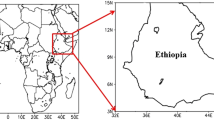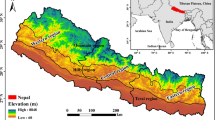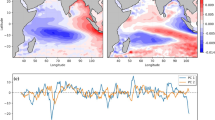Abstract
The study investigates the mechanism of teleconnection between the variability of sea ice extent (SIE) in the Indian Ocean sector of the Southern Ocean and the variability of Indian summer monsoon rainfall. We utilized reanalysis, satellite, in-situ observation data, and model output from the coupled model intercomparison project phase 5 (CMIP5) from 1979 to 2013. The empirical orthogonal function (EOF) and correlation analysis show that the first and third modes of principal component (PC1 and PC3) of SIE in the Indian Ocean sector during April–May–June (AMJ) are significantly correlated with the second mode of principal component (PC2) of Indian summer monsoon rainfall. The reanalysis data revealed that the changes in the SIE in the Indian Ocean sector excite meridional wave train responses along the Indian Ocean for both principal component modes. Positive (negative) SIE anomalies based on first and third EOFs (EOF1 and EOF3), contribute to the strengthening (weakening) of the Polar, Ferrel, and Hadley cells, inducing stronger (weaker) convective activity over the Indian latitudes. The stronger (weaker) convective activity over the Indian region leads to more (less) rainfall over the region during high (low) ice phase years. Furthermore, a stronger (weaker) polar jet during the high (low) ice phase is also noted. The selected CMIP5 models captured certain atmospheric teleconnection features found in the reanalysis. During AMJ, the SIE simulated by the NorESM1-M model was significantly positively correlated with Indian summer monsoon rainfall, whereas the IPSL-CM54-LR model showed a negative correlation.

















Similar content being viewed by others
Explore related subjects
Discover the latest articles and news from researchers in related subjects, suggested using machine learning.Data Availability
The datasets used in this study are available in the ERA-Interim(https://apps.ecmwf.int/datasets/data/interim-full-daily/levtype=sfc/), Met Office Hadley Centre Global Sea Ice and Sea Surface Temperature (https://www.metoffice.gov.uk/hadobs/hadisst/data/download.html), Global Precipitation Climatology Project(https://psl.noaa.gov/data/gridded/data.gpcp.html), National Center for Atmospheric Research (https://climatedataguide.ucar.edu/climate-data/outgoing-longwave-radiation-olr-avhrr) and CMIP5 (https://esgf-node.llnl.gov/projects/esgf-llnl/).
References
Azhar SS, Chenoli SN, Samah AA, Kim SJ (2020) The linkage between Antarctic sea ice extent and Indian summer monsoon rainfall. Polar Sci 25(100537):1–10. https://doi.org/10.1016/j.polar.2020.100537
Bajish CC, Jena B, Anilkumar N (2021) Is the Indian monsoon rainfall linked to the Southern Ocean sea ice conditions? Weather Clim Extrem 34(100377):1–8
Bi D, Dix M, Marsland SJ, O’Farrell S, Rashid HA, Uotila P, Hirst AC, Kowalczyk E, Golebiewski M, Sullivan A, Yan H, Hanna N, Franklin C, Sun Z, Vohralik P, Watterson I, Zhou X, Fiedler R, Collier M, Ma Y, Noonan J, Stevens L, Uhe P, Zhu H, Hill R, Harris C, Griffies S, Puri K (2013) The ACCESS coupled model: description, control climate and preliminary validation. Aust Met Oceanog J 63:41–64
Blackport R, Screen JA (2020) Insignificant effect of Arctic amplification on the amplitude of midlatitude atmospheric waves. Sci Adv 6(8):1–9. https://doi.org/10.1126/sciadv.aay2880
Bracegirdle T, Holmes C, Holland P (2019) Compensating biases and a noteworthy success in the CMIP5 representation of Antarctic sea ice processes. Geophys Res Lett 46:4299–4307. https://doi.org/10.1029/2018GL081796
Bromwich DH, Chen B, Hines KM (1998) Global atmospheric impacts induced by year-round open water adjacent to Antarctica. J Geophys Res 103(D10):11173–11189
Carvalho LMV, Jones C, Tercio A, Ambrizzi T (2005) Opposite phases of the Antarctic Oscillation and relationships with intraseasonal to interannual activity in the tropics during the Austral Summer. J Clim 18:702–718. https://doi.org/10.1175/JCLI-3284.1
Chatterjee S, Ravichandran M, Murukesh N et al (2021) A possible relation between Arctic sea ice and late season Indian Summer Monsoon Rainfall extremes. Npj Clim Atmos Sci 4(36):1–6. https://doi.org/10.1038/s41612-021-00191-w
Chen C, Guan Z, Jiao M, Hu P (2019) Anomalous circulation patterns in association with summertime regional daily precipitation extremes over Northeast China. Adv Meteorol 2019(5085897):1–9. https://doi.org/10.1155/2019/5085897
Clift P, Plumb R (2008) The Asian Monsoon: causes, history and effects. Cambridge University Press, Cambridge. https://doi.org/10.1017/CB09780511535833
Cohen J, Screen JA, Furtado JC et al (2014) Recent Arctic amplification and extreme mid-latitude weather. Nat Geosci 7(9):627–637. https://doi.org/10.1038/ngeo2234
Collins WJ, Bellouin N, Doutriaux-Boucher M, Gedney N, Hinton T, Jones CD, Liddicoat S, Martin G, O’Connor F, Rae J, Senior C, Totterdell I, Woodward S, Reichler T, Kim J (2008) Evaluation of the HadGEM2 model. Met Office Hadley Centre Technical Note no. HCTN 74, available from Met Office, FitzRoy Road, Exeter EX1 3PB. http://www.metoffice.gov.uk/publications/HCTN/index.html
Comiso JC, Gersten RA, Stock LV, Turner J, Perez GJ, Cho K (2017) Positive trend in the Antarctic Sea Ice Cover and associated changes in surface temperature. J Clim 30(6):2251–2267. https://doi.org/10.1175/JCLI-D-16-0408.1
Dima IM, Wallace JM (2003) On the seasonality of the Hadley cell. J Atmos Sci 60:1522–1527
Dugam SS, Kakade SB (2004) Antarctica sea-ice and monsoon variability. Indian J Radio Space Phys 33:306–309
Gadgil S (2006) The Indian Monsoon. GDP Agric Econ Polit Wkly 41(47):4887–4895
Guo D, Gao Y, Bethke I, Gong D, Johannessen OM, Wang H (2014) Mechanism on how the spring Arctic sea ice impacts the East Asian summer monsoon. Theor Appl Climatol 115(1-2):107–119
He J, Lin H, Wu Z (2011) Another look at influences of the Madden–Julian Oscillation on the wintertime East Asian Weather. J Geophys Res 116(D03109):1–18. https://doi.org/10.1029/2010JD014787
Hines KM, Bromwich DH (2002). A pole to pole west Pacific atmospheric teleconnection during August. J Geophys Res 107 (D18): ACL 8-1-ACL 8-20. https://doi.org/10.1029/2001JD001335.
Holmes CR, Holland PR, Bracegirdle TJ (2019) Compensating biases and a noteworthy success in the CMIP5 representation of Antarctic sea ice processes. Geophys Res Lett. https://doi.org/10.1029/2018GL081796
Hoskins BJ, Ambrizzi T (1993) Rossby wave propagation on a realistic longitudinally varying flow. J Atmos Sci 50(12):1661–1671. https://doi.org/10.1175/15200469(2003)060%3c1522:OTSOTH%3e2.0.CO;2
Hu YY, Fu Q (2007) Observed poleward expansion of the Hadley circulation since 1979. Atmos Chem Phys 7:5229–5236. https://doi.org/10.5194/acp-7-5229-2007
Hu Y, Huang H, Zhou C (2018) Widening and weakening of the Hadley circulation under global warming. Sci Bull 63:640–644
Hudson DA, Hewitson BC (2001) The atmospheric response to a reduction in summer Antarctic sea-ice extent. Clim Res 16:79–99
Jin D, Guan Z, Huo L, Wang X (2017) Possible impacts of spring sea surface temperature anomalies over South Indian Ocean on summer rainfall in Guangdong-Guangxi region of China. Clim Dyn 49:3075–3090
Kim YH, Kim MK, Lau WK, Kim KM, Cho CH (2015) Possible mechanism of abrupt jump 607 in winter surface air temperature in the late 1980s over the Northern Hemisphere. J Geophys Res 608 Atmos 120(24):1–12
Lamarque JF, Bond TC, Eyring V, Granier C, Heil A, Klimont Z et al (2010) Historical (1850–2000) gridded anthropogenic and biomass burning emissions of reactive gases and aerosols: methodology and application. Atmos Chem Phys 10:7017–7039. https://doi.org/10.5194/acp-10-7017-2010
Li J, Wang JXL (2003) A modified zonal index and its physical sense. Geophys Res Lett 30(12):34–38. https://doi.org/10.1029/2003GL017441
Li X, Cai W, Meehl GA et al (2021) Tropical teleconnection impacts on Antarctic climate changes. Nat Rev Earth Environ 2:680–698. https://doi.org/10.1038/s43017-021-00204-5
Liu J, Yuan X, Rind D, Martinson DG (2002) Mechanism study of the ENSO and southern high latitude climate teleconnections. Geophys Res Lett 29(14):241–244. https://doi.org/10.1029/2002GL015143
Liu N, Zhang Z, Chen H, Lin L (2011) Western Indian Ocean SST signal and anomalous Antarctic sea-ice concentration variation. Acta Oceanol Sin 30(2):9–13. https://doi.org/10.1007/s13131-011-0100-0
Liu N, Li S (2018) Connection of Antarctic sea ice variability with China summer rainfall on the interannual timescale. American Geophysical Union
Luo X, Zhang Y (2015) The linkage between upper-level jet streams over East Asia and East Asian Winter Monsoon Variability. J Clim 28(22):9013–9028. https://doi.org/10.1175/JCLI-D-15-0160.1
Mahlstein I, Gent PR, Solomon S (2013) Historical Antarctic mean sea ice area, sea ice trends, and winds in CMIP5 simulations. J Geophys Res-Atmos 118:5105–5110
Menzel ME, Waugh D, Grise K (2019) Disconnect between Hadley cell and subtropical jet variability and response to increased CO2. Geophys Res Lett 46(12):7045–7053
Moss RH, Edmonds JA, Hibbard KA, Manning MR et al (2010) The next generation of scenarios for climate change research and assessment. Nature 463:747–756
Nguyen H, Evans A, Lucas C, Smith I, Timbal B (2013) The Hadley circulation in reanalyses: climatology, variability, and change. J Clim 26:3357–3376
Nuncio M, Yuan XJ (2015) The influence of the Indian Ocean Dipole on Antarctic Sea Ice. J Clim 28:2682–2690. https://doi.org/10.1175/JCLI-D-14-00390.1
Ogwang BA, Ongoma V, Xing L, Ogou FK (2015) Influence of mascarene high and Indian Ocean Dipole on East African extreme weather events. Geographica Pannonica 19(2):64–72
Pezza A, Durrant T, Simmonds I (2008) Southern hemisphere synoptic behavior in extreme phases of SAM, ENSO, Sea Ice Extent, and Southern Australia rainfall. J Clim 21:5566–5584
Pezza AB, Rashid HA, Simmonds I (2012) Climate links and recent extremes in Antarctic sea ice, high-latitude cyclones, Southern Annular Mode and ENSO. Clim Dyn 38:57–73
Prabhu A, Mahajan P, Khaladkar R, Bawiskar S (2009) Connection between Antarctic sea-ice extent and Indian summer monsoon rainfall. Int J Remote Sens 30(13):3485–3494. https://doi.org/10.1080/01431160802562248
Prabhu A, Kripalani RH, Preethi B, Pandithurai G (2016) Potential role of the February–March Southern Annular Mode on the Indian summer monsoon rainfall: a new perspective. Clim Dyn 47(3–4):1161–1179. https://doi.org/10.1007/s00382-015-2894-5
Prabhu A, Oh J, Kim I, Kripalani RH, Pandithurai G (2017) SMMR–SSM/I derived Greenland Sea ice variability: links with the Indian and Korean Monsoons. Clim Dyn 50(3–4):1023–1043. https://doi.org/10.1007/s00382-017-3659-0
Pritpal S (2018) Indian summer monsoon rainfall (ISMR) forecasting using time series data: a fuzzy-entropy-neuro based expert system. Geosci Front 9(4):1243–1257
Rai S, Pandey AC (2006) Antarctica sea ice variability in recent years and its relationship with Indian Ocean SST. J Indian Geophys Union 10(3):219–229
Rai S, Khare N, Pandey AC (2008) Antarctica sea ice variability and southeast Indian Ocean SST: possible relationship. Indian J Mar Sci 37(1):35–39
Rashid HA, Hirst AC, Dix M (2013) Atmospheric circulation features in the ACCESS model simulations for CMIP5: historical simulation and future projections. Aust Meteorol Oceanogr J 63:154–160
Rayner NA, Parker DE, Horton EB, Folland CK et al (2003) Global analyses of sea surface temperature, sea ice, and night marine air temperature since the late nineteenth century. J Geophys Res 108(D14):1–37. https://doi.org/10.1029/2002JD002670
Rehman SU, Khan K, Simmonds I (2019) Links between Tasmanian precipitation variability and the Indian Ocean subtropical high. Theoret Appl Climatol 138(4):1255–1267. https://doi.org/10.1007/s00704-019-02891-z
Rudeva I, Simmonds I, Crock D, Boschat G (2019) Midlatitude fronts and variability in the Southern Hemisphere Tropical Width. J Clim 32(23):8243–8260. https://doi.org/10.1175/JCLI-D-18-0782.1
Schneider DP, Okumura Y, Deser C (2012) Observed Antarctic Interannual climate variability and tropical linkages. J Clim 25:4048–4066. https://doi.org/10.1175/JCLI-D-11-00273.1
Screen JA, Bracegirdle TJ, Simmonds I (2018) Polar climate change as manifest in atmospheric circulation. Curr Clim Change Rep 4:383–395. https://doi.org/10.1007/s40641-018-0111-4
Shen H, He S, Wang H (2019) Effect of Summer Arctic Sea Ice on the Reverse August Precipitation Anomaly in Eastern China between 1998 and 2016. J Clim 32:3389–3407
Shi W, Xiao Z, Xue J (2016) Teleconnected Influence of the Boreal Winter Antarctic Oscillation on the Somali Jet: Bridging Role of Sea Surface Temperature in Southern High and Middle Latitudes. Adv Atmos Sci 33:47–57
Shu Q, Qiao F, Song Z, Wang C (2012) Sea ice trends in the Antarctic and their relationship to surface air temperature during 1979–2009. Clim Dyn 38(11–12):2355–2363
Shu Q, Song Z, Qiao F (2015) Assessment of sea ice simulations in the CMIP5 models. Cryosphere 9(1):399–409
Simmonds I (2015) Comparing and contrasting the behaviour of Arctic and Antarctic sea ice over the 35-year period 1979–2013. Ann Glaciol 56(69):18–28. https://doi.org/10.3189/2015AoG69A909
Simmonds I, Budd WF (1991) Sensitivity of the southern hemisphere circulation to leads in the Antarctic pack ice. Q J R Meteorol Soc 177:1003–1024
Simmonds I, Jacka TH (1995) Relationships between the interannual variability of Antarctic sea ice and the Southern Oscillation. J Clim 8:637–664
Simmonds I, Li M (2021). Trends and variability in polar sea ice, global atmospheric circulations, and baroclinicity. Annals of The New York Academy of Sciences. Special Issue: The Year in Climate Science Research, 1–20. https://doi.org/10.1111/nyas.14673.
Simmons AJ, Poli P, Dee DP, Berrisford P, Hersbach H, Kobayashi S, Peubey C (2014) Estimating low-frequency variability and trends in atmospheric temperature using ERA Interim. Q J R Meteorol Soc 140:329–353. https://doi.org/10.1002/qj.2317
Stroeve JC, Kattsov V, Barrett A, Serreze M, Pavlova T, Holland M, Meier WN (2012) Trends in Arctic sea ice extent from CMIP5, CMIP3 and observations. Geophys Res Lett 39:L16502. https://doi.org/10.1029/2012GL052676
Sun J, Wang H, Yuan W (2009) A possible mechanism for the co-variability of the boreal spring Antarctic Oscillation and the Yangtze River valley summer rainfall. Int J Climatol 29:1276–1284
Thomson AM, Calvin KV, Smith SJ, Kyle GP et al (2011) RCP4.5: a pathway for stabilization of radiative forcing by 2100. Clim Change 109:77–94. https://doi.org/10.1007/s10584-011-0151-4
Turner J, Bracegirdle TJ, Phillips T, Marshall GJ, Hosking JS (2013) An initial assessment of Antarctic sea ice extent in the CMIP5 models. J Clim 26(5):1473–1484. https://doi.org/10.1175/JCLI-D-12-00068.1
Turner J, Hosking JS, Bracegirdle TJ, Marshall GJ, Phillips T (2015) Recent changes in Antarctic Sea Ice. Phil Trans R Soc A 373(20140163):1–13
Uotila P, Holland PR, Vihma T, Marsland SJ, Kimura N (2014) Is realistic Antarctic sea-ice extent in climate models the result of excessive ice drift? Ocean Modell 79:33–42. https://doi.org/10.1016/j.ocemod.2014.04.004
Weeks WF (2010) On Sea Ice, Fairbanks. University of Alaska Press, Alaska
Wu B, Zhang R, Wang B (2009a) On the Association between Spring Arctic Sea Ice concentration and Chinese Summer rainfall: a further study. Adv Atmos Sci 26(4):666–678
Wu B, Zhang R, Wang B, D’Arrigo R (2009b) On the association between spring Arctic sea ice concentration and Chinese summer rainfall. Geophys Res Lett 36(L09501):1–6. https://doi.org/10.1029/2009GL037299
Xue F, Guo P, Yu Z (2003) Influence of Interannual variability of Antarctic sea ice on summer rainfall in Eastern China. Adv Atmos Sci 20(1):97–102. https://doi.org/10.1007/BF03342053
Xulu N, Chikooree H, Bopape MM, Nethengwe NS (2020) Climatology of the Mascarene High and Its Influence on Weather and Climate over Southern Africa. Climate 8(86):1–11. https://doi.org/10.3390/cli8070086
Yang CY, Liu J, Hu Y, Horton RM, Chen L, Cheng X (2016) Assessment of Arctic and Antarctic sea ice predictability in CMIP5 decadal hindcasts. Cryosphere 10:2429–2452. https://doi.org/10.5194/tc-10-2429-2016
Yuan X, Martinson DG (2000) Antarctic sea ice extent variability and its global connectivity. J Clim 13:1697–1717
Zhang S, Zeng G, Yang X, Iyakaremye V, Hao Z (2021) Connection between interannual variation of spring precipitation in Northeast China and preceding winter sea ice over the Barents Sea. Int J Climatol. https://doi.org/10.1002/joc.7343
Zhao X, Buwen D, Lu R (2021) Interdecadal weakening of the cross-equatorial flows over the Maritime Continent during the boreal summer in the mid-1990s: drivers and physical processes. Clim Dyn 57:55–72. https://doi.org/10.1007/s00382-021-05692-1
Zhou B, Xu M, Sun B, Han T, Cheng Z (2021) Possible role of Southern Hemispheric sea ice in the variability of West China autumn rain. Atmos Res 249(1053329):1–8
Zunz V, Goosse H, Massonnet F (2013) How does internal variability influence the ability of CMIP5 models to reproduce the recent trend in Southern Ocean sea ice extent? Cryosphere 7(2):451–468. https://doi.org/10.5194/tc-7-451-2013
Acknowledgements
This study is funded by Fundamental Research Grant Scheme (FRGS) Project NoFP059-2019A and the Ministry of Sciences Technology and Innovation Flagship Grant: FP1213E037. It is also strongly supported by the Academic Sciences of Malaysia, Sultan Mizan Antarctic Research Foundation, Malaysian Antarctic Research Program and the Vice-Chancellor of the University Malaya. This work was also supported by the action group Tropical Antarctic Teleconnections (TATE) under Scientific Committee on Antarctic Research (SCAR). S.-J. Kim was supported by the project (PE22030) of the Korea Polar Research Institute. Also, many thanks to everyone who contributed directly or indirectly to the paper.
Funding
This work was supported by Fundamental Research Grant Scheme (FRGS: FP059-2019A), the Ministry of Sciences Technology and Innovation Flagship Grant (FP1213E03) and Academic Sciences of Malaysia, Sultan Mizan Antarctic Research Foundation, Malaysian Antarctic Research Program. Seong-Joong Kim was supported by the project (PE22030) of the Korea Polar Research Institute. Fundamental Research Funds for the Central Universities; Kementerian Sains, Teknologi dan Inovasi.
Author information
Authors and Affiliations
Contributions
All authors contributed to the study conceptions. Material preparation and data collection analysis were performed by SSAA. The first draft of the manuscript was written by SSAA, and all authors commented on all the versions. All authors read and approved the final manuscript.
Corresponding author
Ethics declarations
Conflict of interest
The authors have no relevant financial or non-financial interests to disclose.
Additional information
Publisher's Note
Springer Nature remains neutral with regard to jurisdictional claims in published maps and institutional affiliations.
Rights and permissions
Springer Nature or its licensor holds exclusive rights to this article under a publishing agreement with the author(s) or other rightsholder(s); author self-archiving of the accepted manuscript version of this article is solely governed by the terms of such publishing agreement and applicable law.
About this article
Cite this article
Azhar, S.S.A., Chenoli, S.N., Samah, A.A. et al. The mechanism linking the variability of the Antarctic sea ice extent in the Indian Ocean sector to Indian summer monsoon rainfall. Clim Dyn 60, 2665–2685 (2023). https://doi.org/10.1007/s00382-022-06466-z
Received:
Accepted:
Published:
Issue Date:
DOI: https://doi.org/10.1007/s00382-022-06466-z




